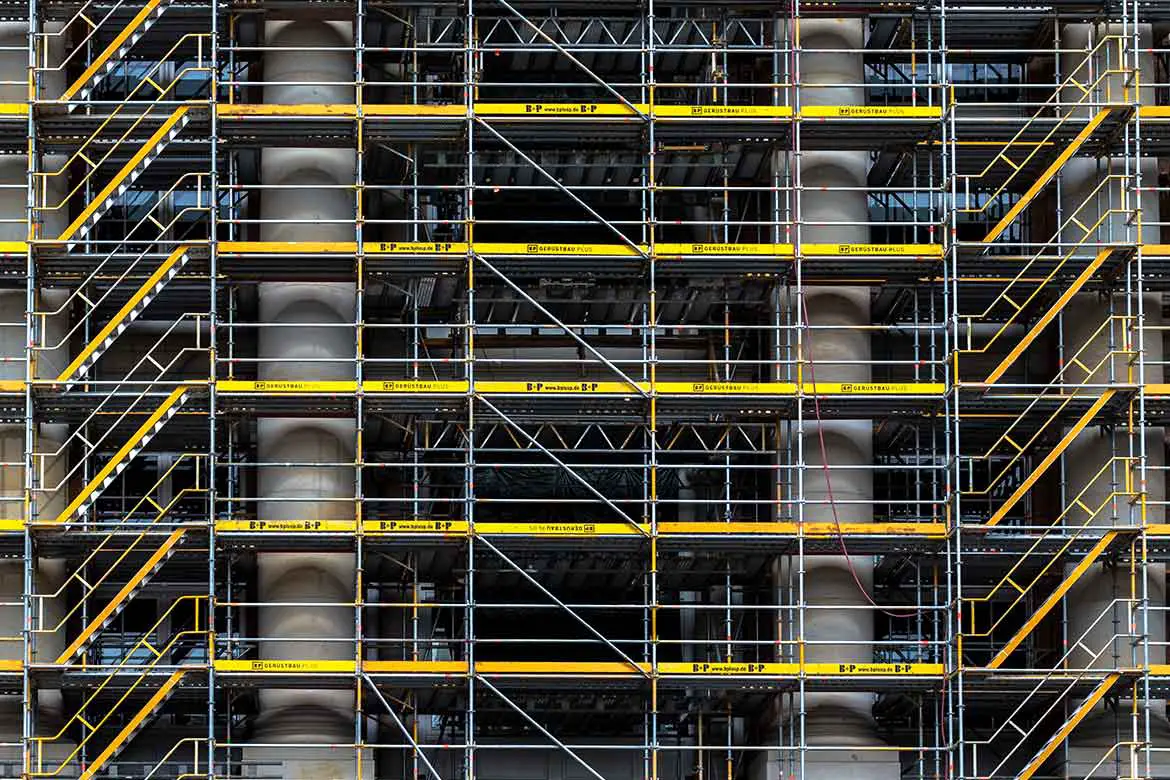For many hundred years, scaffolding has been used in construction. Be it in ancient towns or modern cities, scaffolding has remained popular in every large-scale construction project. Construction managers can hire many workers for various building projects by scaffolding.
What is Scaffolding in construction?
In the construction industry, a scaffold is a temporary platform used to elevate and support workers and materials during the building, repair, or cleaning of a structure or machine. The scaffold consists of one or more planks of convenient size and length, with various methods of support depending on the form and use.
Scaffolding is a temporary structure erected to provide a safe working platform for construction workers. The primary purpose of scaffolding in construction is to provide a stable and secure platform for workers to access and work on high or hard-to-reach areas of a building or structure, such as walls, ceilings, and roofs.
Scaffolding supports workers, their tools, and the materials they need for construction, such as bricks, cement, and steel. It also allows workers to move freely around the construction site while keeping them safe and preventing accidents or injuries.
Scaffolding also helps protect the surrounding environment and people passing by from falling debris and materials and provides access for inspections and maintenance.
Scaffolding can be made of various materials, such as steel, aluminum, and wood. It is designed and erected by qualified personnel in compliance with industry standards and regulations. It is essential that scaffolding is erected correctly, inspected, and maintained to ensure its safety and effectiveness during construction.

There are eight different types of scaffolding:
- Trestle Scaffolding
- Patented Scaffolding
- Suspended Scaffolding.
- Cantilever Scaffolding
- Steel Scaffolding
- Double Scaffolding
- Single Scaffolding
See in the video below eight different types of scaffolding:
Advantages of Scaffolding in Building Construction
- Provides a safe working platform for workers to access and work on high or hard-to-reach areas
- Increases worker productivity and efficiency by providing a stable and secure platform to work on
- Allows for easy movement and access around the construction site, reducing the need for workers to climb and repeatedly descend, saving time and effort
- Protects workers, equipment, and materials from weather conditions such as rain, wind, and heat
- It helps to prevent accidents and injuries by providing a secure and stable platform for workers to perform their tasks.
- Allows for easy inspection and maintenance of the building or structure during construction, reducing the need for additional equipment and resources
- Supports the weight of heavy building materials and equipment, reducing the risk of collapse or damage to the building or structure
- Helps to keep the construction site organized and clean by providing a designated area for materials and equipment.
Below here are my top 3 advantages:
- Adequate Reach
This is the foremost benefit of scaffolding. A scaffold is a small platform made of lightweight metal, fiberglass, or wood. This platform rests above a support structure. This arrangement enables the workers to reach a high ceiling or wall to get their job done. In addition, it helps the workers reach beyond arm’s length.
- Suitable Position
Another plus point of scaffolding is that it lets the person work in an appropriate position. While the worker may reach high walls with the help of a ladder, it is considered less reliable than scaffolding. Unlike scaffolding, a ladder is angled and does not provide proper balance. Scaffolding keeps the worker at an exact position concerning the surface they need to work at without facing risky angles.
This especially proves convenient when leverage has to be used. Further, scaffolding provides more significant space so several workers can work side by side on the same structure. However, this is usually tough in the case of ladders.
- High Level of Safety
The third significant benefit of scaffolding is its safety level. A scaffold is supported by at least four attachment points on the ground. This makes it a sturdy platform to work from, sit, and stand. In addition, a flat structure like scaffolding is steadier than the typical ladder steps. Besides, the scaffoldings are built from solid materials like aluminum, which adds to their durability. Generally, scaffolding comes with a handrail on its top platform. This prevents the workers from slipping, falling, or getting injured while working. As stated, scaffolding accidents are less likely than conventional options like ladders.
Lastly, scaffolding structures are more accessible to assemble and dismantle than other alternatives.





